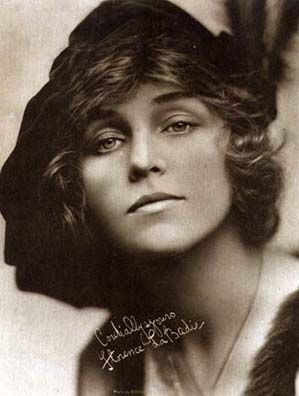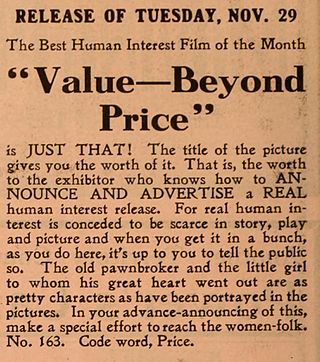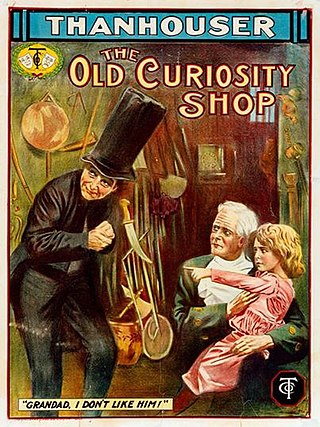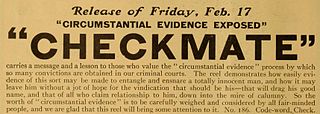Related Research Articles

Florence La Badie was an American-Canadian actress in the early days of the silent film era. She was a major star between 1911 and 1917. Her career was at its height when she died at age 29 from injuries sustained in an automobile accident.
The Thanhouser Company was one of the first motion picture studios, founded in 1909 by Edwin Thanhouser, his wife Gertrude and his brother-in-law Lloyd Lonergan. It operated in New York City until 1920, producing over a thousand films.
The Thanhouser Company was one of the first motion picture studios, founded in 1909 by Edwin Thanhouser. It operated until 1920. It produced over 1,000 films, but several dozen of the films were of small filler subjects, educational or documentaries. Many of these smaller subjects were listed as a quarter or half a reel in length and received very little critical review or analysis by film critics and the media.

Jane Eyre is a 1910 American silent short classic drama produced by the Thanhouser Film Corporation. Adapted from Charlotte Brontë's 1847 novel, Jane Eyre, the film mirrors the events and plot of the original book. The writer of the scenario is unknown, but Lloyd Lonergan probably adapted the work. The film's director is often and erroneously claimed to be Theodore Marston, but Barry O'Neil or Lloyd B. Carleton are possible candidates. The cast of the film was credited, an act rare and unusual in the era.
Thelma is a 1910 American silent short drama film produced by the Thanhouser Company. The story was based on Marie Corelli's 1887 novel of the same name, it focuses on a Norwegian maiden who meets Sir Phillip and the two are wed. Lady Clara conspires to ruin the marriage and tricks Thelma with a letter purported to be from her husband. Thelma returns to Norway and to the death of her father. Thelma, alone in the world, prays at her mother's grave for strength. Sir Phillip searches for Thelma, ultimately finding her, uncovers the tricks which have been played on them and they fall back in love. Released on June 21, 1910, the film was met with praise in The Moving Picture World. An incomplete print of the film survives in the Library of Congress archives.

Gone to Coney Island and Booming Business are two 1910 American silent short comedy productions by the Thanhouser Company. Both were released together on a single film reel on July 5, 1910. Gone to Coney Island is a comedy that features Coney Island, which the mere subject would make for a successful film. Booming Business may have been the very type of slapstick comedy that Edwin Thanhouser specifically said the Thanhouser Company would not produce. The productions of both films have no credits for the cast or crew, but possible candidates for these roles exist. Reviews of the films favored Gone to Coney Island, but some reviewers specifically refused to explain the plot because Coney Island subjects were deemed self-explanatory. Booming Business received one detailed review in The New York Dramatic Mirror which was negative. The films are presumed lost.

Uncle Tom's Cabin is a 1910 American silent short drama produced by the Thanhouser Company. The film was adapted by from the 1852 novel Uncle Tom's Cabin by Harriet Beecher Stowe. The plot of the Thanhouser production streamlined the actual story to portray the film over the course of a single reel. The film was released on July 26, 1910, on the same day that Vitagraph released the first reel of their own three reel version of Uncle Tom's Cabin. This prompted the Thanhouser Company to advertise against the Vitagraph film by referring to the other as being overly drawn out. The film garnered mixed, but mostly positive reception in trade publications. The film is presumed lost.

The Girls He Left Behind Him and The Iron Clad Lover are two 1910 American silent short comedies produced by the Thanhouser Company. Both films were originally released together on a single reel and are two distinct and separate subjects. The Girls He Left Behind Him focuses on a young man, Jack Redfern, who receives a letter from an old sweetheart of his. This prompts him to reminiscence about all the girls he has had affections for on the eve of his wedding. All the old sweethearts of his life then appear at his wedding to wish him well. The Iron Clad Lover concerns two suitors who are vying for the affections of Bessie. Tom, who plays a game of chess with her father, ends up quarreling with him and he is thrown out of the house. The next day, Tom attempts to bring flowers and candy for Bessie's birthday, but is dismissed by the angry father. Tom decides to dress up in a suit of armor and ends up breaking a vase when trying to announce himself. The suit of armor is thrown out and Bessie and the other suitor chase down the junk dealer to free Tom from the suit of armor. Both films were released on December 9, 1910 and were met with positive reviews by The Moving Picture World and the New York Dramatic Mirror. Both films are presumed lost.

Value—Beyond Price is a 1910 American silent short drama produced by the Thanhouser Company. The film focuses on a family beset by tragedy when the father is presumed dead after his ship is lost at sea. The mother struggles to support her child and sells her possessions to a pawnbroker. When she has nothing left, save her wedding ring, the pawnbroker asks to take care of the child and the mother consents. The pawn broker gives her a pawn ticket for the girl stating "a precious jewel, a value beyond price" and tells her she can redeem it at any time. Before her death, she entrusts the ticket to a friend. Ten years pass, the shipwrecked father has discovered a great fortune on the island and is rescued by a passing steamship. The father soon realizes his wife is dead and his child is missing, but he receives the pawn ticket and decides to claim this jewel his wife had left for him. He redeems it at the pawn shop and finds it is his lost daughter. The film was released on November 29, 1910 and it was met with positive reviews. The film survives in the Library of Congress archives.

The Childhood Of Jack Harkaway is a 1910 American silent short drama produced by the Thanhouser Company. Adapted from Bracebridge Hemyng's Jack Harkaway story series by Lloyd Lonergan, the film depicts the life of the title character. Given to the care of strangers after his birth, Jack grows up and is sent to a school at age 12. After being severely and unjustly punished by the schoolmaster, Jack runs away and comes across two thieves plotting a robbery. Jack hurries to the house and warns the mistress of the planned robbery. The robbery is foiled and the lady of the house is very grateful, but Jack's schoolmaster and his guardian arrive to take him back. She recognizes the guardian as the man who forced her to turn over Jack and turns them out of the house. The film's cast and production credits are unknown. The film was released on December 23, 1910, it was met with favorable reviews and saw a wide national release. In 1988, a severely deteriorated nitrate print of the film was known to exist and it was likely transferred to the Library of Congress archives in 1997.

Everybody Saves Father and The Only Girl in Camp are two 1910 American silent short films produced by the Thanhouser Company. Both films were released together on a single reel on January 10, 1911. Everybody Saves Father is a comedy focusing on a father whose life is planned to be saved by a succession of his daughter's suitors. The plan of each of the three men work, foiling the attempts of the other, but a four suitor has wed the daughter whilst the scheming was done by the others. The Only Girl in Camp is a drama film focusing on the only girl in a mining town who foils an armed robbery with the use of bear traps. In 2009, The Only Girl in Camp was identified and deposited into the Library of Congress for preservation. The only known credits for the production come from film stills from the film. The reviews for Everybody Saves Father were positive, but The Only Girl in Camp was met with more or less neutral reception.

Bertie's Brainstorm is a 1911 American silent short drama film produced by the Thanhouser Company. The film focuses on Bertie Fawcett, a dim-witted fop, who erroneously believes to have won the heart of May Vernon. In reality, May loves Jack and the two are set to be married, but May's father wishes he would prove his worth by earning his own living. Bertie chances upon the letter and sets off to make a living proceeds through a number of jobs with hope to claim May as his bride. The film ends with Bertie returning and finding out that May has married Jack. Little is known about the production of the film save that William Russell played an unknown role and that the scenario was written by Lloyd F. Lonergan. The foppish character of Bertie may have been inspired by Edwin Thanhouser's role as Bertie Nizril in Thoroughbred. Originally conceived as a series, this ultimately singular work received praise from critics. The film is presumed lost.

The Old Curiosity Shop is a 1911 American silent short drama film produced by the Thanhouser Company. The film is an adaptation of the 1841 novel The Old Curiosity Shop by Charles Dickens that was limited to the time constrictions of the single reel format. The film focuses on the grandfather who gambles into poverty and the consequences which eventually claim the life of Little Nell. Its survival and attribution as a Thanhouser film was noted by Kamilla Elliott in her 2003 book Rethinking the Novel/Film Debate under the title Little Nell. In 2012, the work was confirmed to be a Thanhouser production at the Pordenone Silent Film Festival. The identification of the film as Little Nell arose due to head of the film having been lost.

Checkmate is a 1911 American silent short drama film produced by the Thanhouser Company. Focusing on the subject of convictions by circumstantial evidence, the plot has a French baron and an American businessman vie for the affections of an heiress. She chooses the American and the French baron conspires with the heiress's aunt to take revenge. The American falls into their trap and is accused of stabbing the baron by the conspirators. The circumstantial evidence was enough to convict him and he is sent to prison. Through the aid of a homeless doppelgänger who looks like the fiancé, he is substituted in prison and the original forces a confession from the aunt. For his plot, the baron is convicted of perjury and sent to prison. Released on February 17, 1911, the film was a critical failure for its improbable plot and its prison substitution scene. The film is presumed lost.
References
- ↑ Thanhouser, Ned (February 25, 2012). "Thanhouser Filmography Analysis". Thanhouser Filmography. Thanhouser Company Film Preservation, Inc.
{{cite web}}: Missing or empty|url=(help) - ↑ Thanhouser, Ned (October 20, 2014). Thanhouser Film Database. Thanhouser Company Film Preservation, Inc.
{{cite web}}: Missing or empty|title=(help); Missing or empty|url=(help)